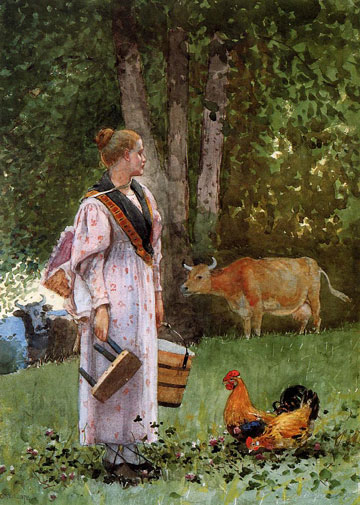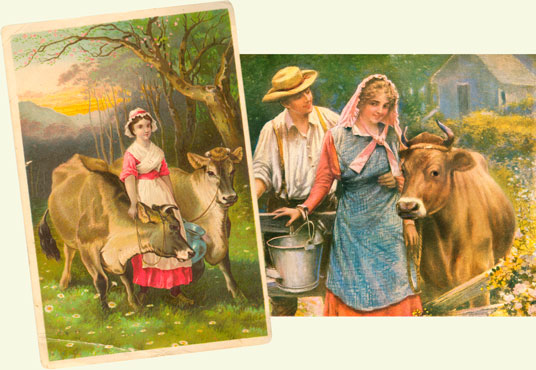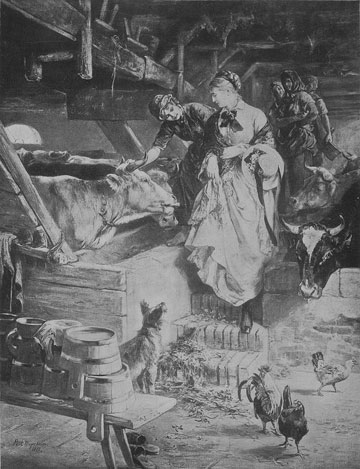Conformation Standards
![[flourish]](/images/flourish-txt_mobius.png)
A Heritage Jersey is that cow in the iconic frozen-in-time portraits of turn-of-the-century milkmaids or a solitary woman milking her cow in the pasture—a cow of manageable size and temperament that produces rich, creamy, life-giving milk; a cow that has a small frame and from her head down, has smooth lines. While more angular than rounded, her body flows elegantly. Her overall appearance is that of a sweet, simple, and classic beauty.
Her face is kind and refined—forming an acute triangle from her nose or muzzle, back along her jaw line, up to her poll or the crown of her head, and gently sliding back down the bridge of her nose. Her ears are alert and large, yet still proportionate. She has bright, large, knowing eyes that are set evenly on either side of the bridge of her nose—eyes that beckon you to fall in love with her.
Her strong and elegant neck flows back to her shoulders and down into her chest. Her withers, where her shoulders meet her neck, are sharply angled to the ground but still splayed enough to allow for a wide chest—a chest that fits a good pair of lungs and a big heart.
Her front legs extend down, strong and straight, able to support the weight of her body. Her knees and hooves (feet) may have a slight outward turn to them. The hooves should be large enough to comfortably hold the weight of her frame and full udder of milk, but never clunky, always slender.
Her barrel or center of body, between her front legs and hips, should be more wide than long. A line drawn around her body just behind her front legs forms her heart girth, and the space stretching back to just in front of her hips or hook bone forms the barrel. The barrel of a Heritage Jersey must be able to hold a large stomach that fuels her and her milk production and still has extra room for a growing calf. From her neck to her heart girth and the width of her barrel to her tail should split her frame into three somewhat equal parts.

Her hips are set wide for calving ease and legs that leave room for a large udder. Her hocks, or the knee of the rear legs, are set slightly back and turned out but are strong and straight enough to support her frame. Her udder floor is above her hocks.
Her udder is prominent, yet proportionate to her overall frame. From the front attachment of her udder under her barrel, the udder expands through her legs and curves up smoothly and attaches high up between her legs.
All four quarters—the sections of the udder—are evenly set and of similar size. The udder should be no larger than her frame can support.
Her teats are set slightly wide of center and evenly spaced on the four quarters of her udder. The rear teats should be set for convenient access. The teats should be firm and fit in the palm of your hand nicely. If they are too large, calves might have difficulty nursing. They should not drip milk; however, it should be easy to squeeze milk from them.
Jerseys come in a wide range of colors. They can have solid or broken colors that vary from white to very light gray to tan with varying degrees of subtle red to different shades of fawn to black. Some Jerseys have white patches on their shoulders, faces, hips and legs. Their switches (long hair at the end of their tail) can be black or white. Their trademark coloration is their dark, knowing eyes surrounded by dark pigmented skin and dark noses accented oftentimes by a lighter band around their muzzle. Mature bulls are commonly darker around the hips and the head and shoulders because of their levels of testosterone. Jersey lovers vary in their color preference, but everyone agrees that a cow’s ability to produce is far more important than her shade of color or whether or not the color is solid or broken.
They are a naturally horned breed, although there are genetics for polled Jerseys as well.
The Heritage Jersey is the dairy queen of milk production. She is the top in milk quality, milking ease, health of udder and body, birthing, overall manageable temperament, and the grand champion of efficiency.

1878 Winslow Homer, Artist
A Heritage Jersey will produce milk with a high amount of cream, rich in butterfat and protein. Properly cared for, she has a very low occurrence of udder health problems. Comparable to her small frame size, she produces a generous amount of milk, enough to feed a calf and provide for a family.

Her temperament is calm and unafraid, with an ease that makes her manageable for all members of her family. After all, that is her purpose, to provide delicious, life-giving milk for the family who loves and cares for her.
We at the Heritage Jersey Organization know there are very good Jersey cows that don’t meet this exact description. These are breed characteristics for the ideal Heritage Jersey. Over time, we’ll develop a classification system using a scale of points, setting forth categories for evaluation—things like stature, back, rump and tail, feet, legs, dairy character, chest and barrel, polled or horned, fore udder, rear udder, teats, mammary system, etc. But we’re in the early stages for anything other than general breed character.
We would like to encourage breeders to keep these characteristics in mind when mating a pair, and we would like buyers to keep them in mind when looking for a cow. But our main purpose is to emphasize and support the community of people who own or long to own this classic beauty called a Heritage Jersey.

1892 Paul Friedrich Meyerheim, Artist
“Looking up, he saw a succession of maid-servants carrying pails filled with milk to the dairy.”